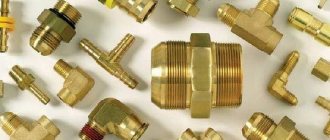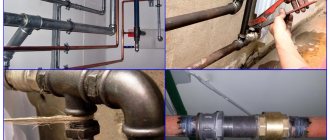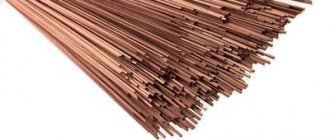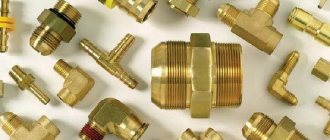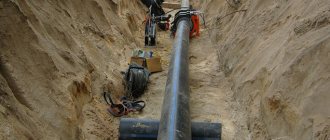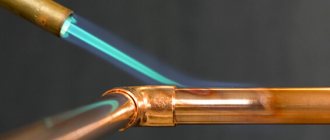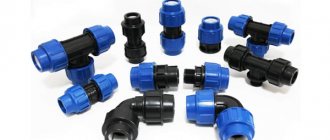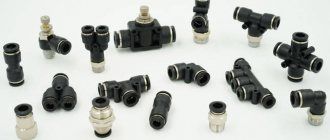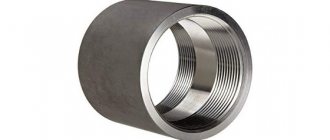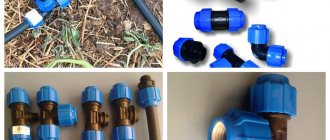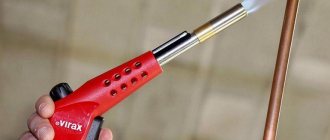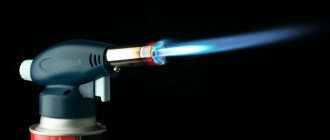Nowadays, copper pipes remain a popular and versatile material that is widely used in the creation of heating water and gas systems.
They are not afraid of chlorinated water, which makes copper pipes especially attractive for installing city water supply systems.
In addition, copper is not afraid of corrosion and has a long service life, which is very, very good in any case.
Installation of copper pipes is carried out using various types of connections.
crimp fittings for copper pipes is also popular today .
General information
The optimal solution during the installation of water supply in cities is the use of pipes made of this material. Copper products are not subject to corrosion and have a long service life.
Reference! Products are mounted using different methods: by soldering, welding, or using fittings for copper pipes for crimping.
Positive and negative characteristics of products. Installation of pipelines using compression fittings is quick and easy. This method does not require the use of high temperatures or special equipment.
The installation method allows you to work in hard-to-reach places; for this you need tools in the form of:
1. spanners.
2. calibrator.
3.cutter
The time required to carry out the work is short, but the pipeline is obtained with a high level of tightness and can serve for a long time.
The disadvantages of the element for connecting the structure include the need to periodically check if the fitting needs to be tightened.
Important! Since the fittings require constant checking, they cannot be installed under a concrete screed.
The parts are designed for systems with low pressure, since the fastening is less reliable than that of pipes connected by soldering.
If you use crimping devices during connection, the design can be used many times.
Attention! The joints can be disassembled and reassembled many times, but the strength of the connection will gradually decrease.
Advantages of using fittings
Connecting pipes with compression fittings does not require high temperatures or special equipment. Using fittings, you can install pipes in hard-to-reach places. To do this, you will need a set of tools consisting of wrenches, a calibrator and a cutter.
Compared to soldering and welding, the use of compression fittings reduces the time required for work and reduces labor costs. The pipeline will be sealed and durable. The only disadvantage of crimping a copper pipe is the need to periodically check and tighten the fittings, therefore, the impossibility of concreting them.
How the fitting works
The compression fitting consists of:
1.cases.
2.crimp nut.
3.Frimp ring. Can be equipped with one or two rings, designed to seal the connection, protect against high pressure, and increase the wear resistance of the system.
Attention! It is better to use EPD M material as a sealant, as it has a longer service life.
These devices are manufactured:
1.made of brass.
2.made of copper.
3. made of plastic.
4.made of metal.
In copper structures, brass fittings are used; they do not require special care during operation and are inexpensive, unlike copper parts. In terms of strength, they are not inferior to steel parts, but have simpler assembly. To give parts more durable properties, nickel coating is used.
When purchasing, pay attention to the weight of the products; you don’t need to buy ones that are too light; it’s better to focus on products from well-known brands. This way you can ensure long and reliable operation of the system.
Design and principle of operation of a compression fitting
Diagram explaining the connection principle
A compression fitting for copper pipes consists of several parts:
- housings;
- crimp nut;
- ferrule ring.
Ferrules (usually one or two) are designed to create a sealed connection and provide high pressure resistance and durability. Thanks to them, the structure becomes resistant to vibration fatigue and can serve for many years.
High-quality crimp fittings for copper pipes can last up to 50 years.
Advice! It is better to choose parts in which special EPD M material is used for connecting rings, rather than ordinary rubber, as they will last much longer.
Compression fittings are made from:
- brass,
- copper,
- plastic,
- metal
At the same time, brass connecting elements are most often used for copper pipes, since this material is easy to process and costs less than pure copper. It is inferior in strength to stainless steel, but it is much easier to install.
Sometimes brass fittings are additionally treated with nickel to increase resistance to various influences.
When choosing, pay attention to the weight of the product; this indicator should not be too light. You can ask the seller for a quality certificate; in addition, professionals advise immediately choosing parts from a well-known manufacturer.
This ensures that you do not waste your money and that the installed system is reliable. Many people advise using a brass fitting for HDPE pipes, as it is not subject to corrosion, but provides a greater margin of safety than plastic.
Types of devices
There are several types of devices:
1.tees, which are used for branching in one direction.
2.crosses are used to make branches in several directions.
3. couplings are used to connect products having equal diameters.
4. Bends are used to form turns.
5.plugs are installed at the ends of the workpieces.
To connect pipes with equal sections, parts with a straight design are used, and if the diameters are different, adapters are used.
Types of transition elements:
1.threaded type.
2.compression type.
3. capillary type.
4.press - fitting.
5.self-locking.
Types of crimp fittings
Video
Copper fittings
These devices come in the following types:
- Tee. For installation of branches in one direction;
- Cross. For a branch device in two directions;
- Clutch. Used to connect pipe blanks that have the same diameters;
- Retraction. Apply to create a turn;
- Stub. Placed on the end of the cut piece.
For the joint of pipes that have the same diameters, straight parts are used, and for different diameters a transitional option is used.
By type they are divided into:
- Threaded;
- Compression;
- Capillary;
- Press fittings;
- Self-locking.
Threaded type
This type of fitting is simple in design, easy to install, but requires modification.
The best option for copper pipes is considered to be fittings made of brass. The parts have a high level of corrosion resistance; they are used for sections of the pipeline that are fixed to the wall.
Attention! These fittings are not suitable for combination with rolled pipes made of plastic material, copper or metal-plastic, since when twisting the elements, the softer material of the workpiece can be deformed.
Compression type
In situations that do not allow the use of open fire, a compression type fitting is installed. Fittings are used to connect pipes of different and identical sizes, made of different materials.
These fittings are manufactured:
1.made of brass,
2.made of copper.
3.made of metal-plastic.
4. made of plastic.
5.made of steel.
The fittings are equipped with a crimp ring, with which they are attached to the pipes, creating a tight connection. The ring is tightened manually using a nut and a wrench.
Attention! This type is suitable for use in confined spaces with inconvenient access.
Capillary type
This type is best suited for connecting copper or steel pipes. Along the entire thread, the inside is equipped with a thin wire made of tin, copper or silver, with the help of which the product is soldered.
The pipe is pre-coated with flux and connected to the fitting. Using a torch, heat the joint area until the solder melts and fills the internal space.
Next, the connection is allowed to cool, after which the joint area is cleaned using products intended for copper products.
Attention! The type of fitting and its connection method is considered the most durable and is best suited for installation in copper pipelines.
Self-locking type
Fittings that can self-lock are mechanisms. The device consists of an inner ring, one ring is equipped with teeth. By pressing the device with the puller key, they cling to the adjacent ring.
The joint method has a reliable and durable fastening. The fitting can be used many times because it is easy to remove and reinstall.
The devices are made of copper for joining pipes of different diameters and materials. The method is most convenient for use in large pipelines made of various pipes.
Features of installation of a crimp fitting on a copper pipeline.
Attention! This fitting does not require the use of special equipment; they are easy to install yourself.
In European markings, two types of crimps are distinguished, denoted by the letters A or B.
A fittings can be used for above ground piping and are made from semi-solid copper or stainless steel.
B fittings can be used in above-ground and underground systems and are made using soft or semi-hard copper with thick walls.
Attention! To reliably connect the elements, you must follow the instructions.
Types of Copper Pipe Fittings
Fittings are necessary when assembling pipelines to create reliable detachable and permanent connections. The result of a properly made connection is the operation of the network without repair for 15 years or more. Let's look at what types of fittings are used for copper pipes.
Option #1 – compression
Soldering is not used to install compression fittings. Collet structures are called conditionally detachable, since they create a sealed connection that needs tightening from time to time. In this regard, pipelines cannot be sewn into the floor or walls.
The top image shows a compression fitting for a copper pipe: a body, a split ring (which acts as a seal during assembly) and a union nut, which is tightened to perform the crimping.
To install a compression fitting, no special tool - pliers or clamps - is needed. First, crimping is done manually, and then the union nut is tightened with an adjustable or open-end wrench.
Image gallery
Photo from
Compression fitting
Components of a compression fitting
Sealing ring in compression joints
Installation of shut-off valves
It is recommended to use a pair of keys: one to hold the body, the other to perform semi-rotational movements. For a strong connection, 2-3 additional turns are usually enough.
Push-in fittings have standard dimensions - according to the cross-section of the pipes, and their inner wall is pre-calibrated (for making a socket connection). In addition, they differ in purpose. Let's assume that parts for the plumbing and heating systems may differ in design.
Option #2 – press fittings
Compression fittings have a completely different design. They have a tubular structure, and each end is equipped with a recess with a seal. The principle of mounting on a pipe is based on one of the qualities of copper as soft and pliable when processing metal.
Image gallery
Photo from
Structure of a crimp press coupling
Tool for forming a press connection
One-piece connection option
Press technology in open gasket
During the crimping process, the design of the part is deformed in such a way that the material with the sealing ring creates a permanent, hermetically sealed connection.
Sample of a bronze press fitting for copper pipes with a threaded connection. The manufacturer is the well-known company VIEGA. Price – 880 rubles (parts for crimping made of brass, bronze or copper are much more expensive than their steel counterparts)
To assemble a pipeline using press fittings, you need a special tool - press pliers. For temporary and one-time work, a manual device is suitable, but with constant professional use it will quickly cause fatigue.
For qualified plumbers, hydraulic and electromechanical models are available - expensive, but saving energy and time.
Types of press fittings that differ in purpose and design: straight coupling connectors, adapters, crosses, simple elbows and adapters to another diameter
The difficulty of pressing is that after crimping it is sometimes difficult to distinguish a processed fitting from one simply put on the pipe. To avoid any omissions, manufacturers have equipped the parts with special signal elements that change their appearance after crimping: bright plastic rings or deformable bulges called SC-Contur.
It is not difficult to distinguish parts by purpose, since they are marked with a marker of different colors:
- blue or red – water supply (drinkable or non-drinkable);
- green – heating;
- yellow – gas supply.
There are also universal options: for example, yellow-blue markings indicate that the fittings can be used in systems for moving gases and water. Color is also used to mark the seal (yellow for gas, black for water, etc.)
Option #3 – for soldering
Soldering provides a strong and permanent connection between two pipe fragments. This is done using a special tool. Immediately before soldering, the ends of the pipes are overlapped, that is, a socket joint is used.
However, there should be a small gap between the walls, which is necessary for filling with molten solder. The gap size is from 0.02 mm to 0.4 mm.
The configuration of copper fittings for soldering corresponds to analogues for pressing: straight, corner, crosses, etc. The photo shows a corner element intended for a heating system
The main tool for soldering is a torch, but for the initial processing of pipes they also use a calibrator (expander), a chamfer, a pipe cutter and all kinds of cleaning tools (brushes, sandpapers).
A hand burner with a 200 ml gas cartridge is suitable for home use. A lightweight and convenient hand-held device produces a flame with a temperature of + 1100 °C, which is quite enough to melt soft solder.
In addition to the torch, you will need tin-based solder (with silver, bismuth, antimony), the melting point of which is much lower than that of copper. The temperature difference ensures the integrity of the copper pipes is maintained and the solder effectively melts to a liquid state so that it can fill the gap and tightly connect the parts
You will also need a flux solution that is used to lubricate the connecting parts of the fitting and pipe.
The surface of copper parts is coated with flux using a brush. It ensures uniform spreading of solder over the joint area.
Classification of copper fittings for soldering. They are cheaper than crimp analogues. The material of manufacture is copper grade Cu-DHP, which is suitable for both types of welding, low and high temperature
For self-soldering, low-temperature technology is usually used. Fittings for this type of welding are equipped with a strip of soft solder, which is placed in a special encircling groove.
The high-temperature welding method is used in production and when creating industrial networks. Distinctive features are the use of hard solder, and further the ability to move gases and liquids under high pressure. Read more about how copper pipes are soldered in this material.
Installation work for installing a fitting for crimp type A
Installation has step-by-step instructions:
1.select the required element size. The work is easy to do, since all parts are manufactured according to European standards.
2. The workpiece is cut to the required length, and the burrs are removed. All cut ends are checked using a gauge. If necessary, remove dirt from the pipe, grind the damaged edges, and then put on a crimp ring.
Important! The area to be connected is wetted with water to prevent the seal from moving and breaking.
3. The pipe is inserted into the fitting as far as possible, the clamping nut is first tightened by hand, and screwed in until it stops using a wrench.
Important! You should not overdo it, the level of tightness will not change, but the likelihood of tearing off the ring and ruining the reliability of the joint increases.
Upon completion of the work, the rolled pipe may be deformed, this is evidence that the joining was successful and the structure is airtight.
Installation work for installing a fitting for crimp type B
This type has approximately the same installation scheme. The cut area is cleaned of contamination, attention is paid to the thread, and the thread is allowed to be lubricated with machine oil.
This makes for an easier connection to the pipe. It is necessary to control the position of the sealing cone; it should be pressed against the workpiece from the inside, while the edge of the pipe should be flared.
It is important to choose the right wrench; it must match the size of the nut so as not to damage it. For example, a 750 mm wrench fits a 54 mm nut.
Installation nuances
Copper pipes are expensive; when choosing materials, you should adhere to the following rules:
1. It is better to choose a pipeline from one type of material so that the structure lasts for many years.
2. It is not recommended to combine copper pipes and products made of non-alloy steel. The effect of electrochemical processes on the joints that occur between them has a detrimental effect, forming rust on steel parts.
3. if it is impossible to do without pipes made of different materials, then steel pipes are laid before copper pipes in the direction of liquid transportation.
4. Copper pipes can be combined with PVC products, which will not entail any negative consequences.
Methods for connecting copper pipes
In practice, one of two methods is used to assemble copper pipelines - by soldering or mechanical crimping.
Secrets of soldering with a gas torch
When choosing a soldering method for installing the system, you must consider the following: all connections made in this way are permanent. Soldering provides a high percentage of density guarantee, but imposes some restrictions on maintenance. It is often impossible to upgrade a system without adding complexity.
So, if it is necessary to change some part of the water supply (heating system), for example, due to the introduction of new equipment, difficulties may arise. You will have to use a gas torch and soldering technique again just to be able to introduce a coupling, tee or other part into the system.
Therefore, solder joints are used in hidden plumbing projects embedded in walls or under floors.
The soldering process is inextricably linked with the operation of the gas burner (open fire and combustion products). Therefore, this technique is not always suitable for installation, especially in rooms where a fine finish was previously carried out.
Step-by-step soldering installation process:
- Two pipes are cut to size. The end area is cleared of burrs.
- The end part of one of the pipes is expanded with a calibrator - a socket is made.
- Use a wire brush and sandpaper to clean the soldering areas until they shine.
- Cleaned surfaces are treated with a flux solution.
- The processed parts are inserted one into the other.
- The joint is heated with a burner to the melting temperature of the solder (350-500ºC).
- The end of the solder rod touches the lower edge of the socket.
Under the influence of high temperature, the solder melts and rushes into the gap area between the walls of the pipe and the socket due to the capillary effect created by flux evaporation. This results in a neat and high-quality solder connection. This is just one example of pipe-in-pipe soldering.
Soldering with fittings and other elements is carried out in the same way.
Step-by-step instructions for soldering copper pipes, as well as technical nuances of the work, are given in this article.
Connection with compression fittings
It is much simpler and easier to install copper pipes with your own hands if you use another widespread technology - mechanical crimping. In this case, special fittings are used to create a connection between copper pipes.
Approximately the same elements are used when working with polypropylene pipes. But for copper they make a slightly different design of the crimp ring - one-piece, without a cut.
Compression fittings are made of brass. Judging by the degree of ductility of materials, these values for copper and brass are almost the same
An important feature of the brass-copper pair bond is the almost complete absence of galvanic connection between the materials
This factor guarantees the cleanliness of the connection during operation - the absence of oxides, corrosion, etc.
The situation is completely different with aluminum. This metal, unlike brass, is galvanically bonded to copper. Under conditions where tap water is saturated with salts, that is, it is an active electrolyte, a favorable environment for the occurrence of an electrochemical reaction is formed.
Under the influence of this reaction, aluminum is destroyed. Therefore, direct connection of copper pipes and aluminum radiators (or other aluminum devices) is undesirable. For example, steel transitions should be used.
Installation of crimp fitting:
- The end area of the pipe is cleared of burrs.
- A nut, ferrule, and fitting are put on the end of the pipe.
- Using a wrench of the required size, the fitting is held in one position.
- Use the second wrench to screw the nut onto the thread of the fitting.
The tightness of the connection is achieved by uniformly pressing the crimp ring along the diameter of the copper pipe. It is not recommended to use extreme force when tightening the nut. From the initial stop, it is enough to tighten the nut 1-2 turns.
The advantages of using press connectors are that they can be disassembled and reassembled if necessary. But at the same time, the quality of the seal of such connections is influenced by changes in the temperature of the external and internal environment.
Often, due to temperature changes, crimp connections leak. This defect can be eliminated simply and quickly by tightening the union nut.
However, for hidden installation of a water supply system, the method of crimping push-in connections of copper pipes is clearly not suitable.
